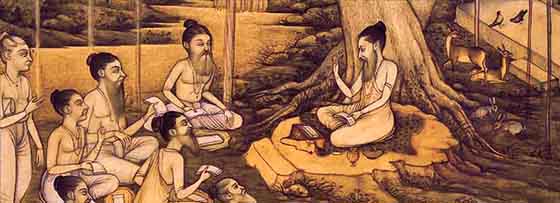
Overview
Ayurveda is known as knowledge of life. The very much history of Ayurvedic system of medicine starts when the Vedas (Rigveda, Yajurveda, Samaveda and Atharvaveda) were created.
According to ancient Indian mythology, the essence and concept of Ayurveda came into existence by Brahma (the creator of the universe or the world). Ayurveda is considered the essence and concept of Atharvaveda. Ayurveda is also known as 5th Veda. The fourth veda, Atharvaveda contains 114 hymns for Ayurvedic way of treatment of diseases. Ayurveda has developed from the hymns written in Atharvaveda.
The time of the Vedas (Rigveda, Yajurveda, Samaveda and Atharvaveda) dates back to approximately to five thousand years back. The Vedas teach us the fundamental philosophy of the human life. The fourth veda, the Atharvaveda describes the principles and practices of medicine on which fundamentals of Ayurveda are based. ‘Ayur’ signifies ‘life’ in Sanskrit fraternity. Ayurveda is the oldest system of healing and it promotes the longevity. Ayurveda has impact on ancient systems of healing (Greek, Tibetan, and Chinese medicine). This is the reason, Ayurveda is described as mother of all other healing sciences).
References for medicine can be located in the ancient texts which includes the Vedas. Ayurveda originated from Brahma (the mythological creator of the universe), who passed on the knowledge to Daksa Prajapati. Daksa Prajapati passed the knowledge of Atreya Punarvasu. The first veda, the Rig Veda describes the divine powers of physician Rudra and the cure of senility of Chyavana by the Aswini Kumaras. The knowledge of medicine is found scattered in the the Rig Veda, but comprehensive and systematic details of the diseases and their cures can be located in the Atharva Veda only.
The Ayurvedic teachings were transformed orally from the teacher to the student for a time span lasting for 1000 years. Ayurveda has great impact on the primary health care principles and practices in the west as well as the east. During 400 AD Ayurvedic texts were translated into Chinese context and approximately by 700 AD Chinese students started visiting India were for studying medicine at Nalanda University.
Ayurvedic knowledge has great impact n Buddhist philosophy Chinese medicine, and principles of herbology. Later on texts (samhita) were composed. Charaka Samhita, a classic Ayurvedic lexocon, parallels the time frame of the fourth veda, the Atharvaveda. Charaka Samhita was written in the Indus Valley approximately around 1000 B.C. by the great Acharaya, Charak in Sanskrit. Charaka Samhita, is basically a treatise kayachikitsa (general medicine). Sushruta, a famous surgeon as well as disciple of Dhanvantari compiled Sushruta Samhita, a treatise on shalya tantra (sugery).
Ayurveda’s spreading impact in the non Indo-European countries started after the dawn Buddhism (6th century B.C.E.). Buddhist monks were instrumental in introducing Ayurveda to other Asian countries (Mongolia, Tibet China, Sri Lanka and Korea), leaving a lasting ever-lasting legacy in their healthcare systems. Later on scholars in the medieval time felt the need to assemble the work on Ayurveda at one stage. Maximum work was done between eight to fifteenth century A.D.
| Sr. No. | Name of the Nighantu | Author | Time |
| 1. | Astangta | Vagbhata | 8th |
| 2. | Paryaya ratnmala | Madhava | 9th |
| 3. | Dhanvantri | 10th | |
| 4. | Arundutta | Arundutta | 12th |
| 5. | Sodhala | 12th | |
| 6. | Madhava dravyaguna | 13th | |
| 7. | Hrdaya deepika | Bopadev | 13th |
| 8. | Madanpala | 14th | |
| 9. | Kaiadeva | 15th |
Table 1 : It shows work on nighantus written between 8th to 15th centuries
After Sixteenth Century, Several Nighantus were Composed
| Sr. No. | Name of the Nighantu | Author | Time | Salient Feature |
| 1. | Bhavapraksha | Bhavamishra | 16th | Description of rasa karpura |
| 2. | Raja nighantu | Madhava | 17th | Special account on dravyaguna |
| 3. | Siva kosha | Shiva dutta | 17th | Self explanatory |
| 4. | Nighantu sangraha | Raghunatha | 17th | |
| 5. | Shaligrama Vanaushadi | Shaligrama | 17th | Account of modern drugs |
| 6. | Gunadarsa | Shankaradaji | 19th | |
| 7. | Hrdaya deepika | Bopadev | 13th | |
| 8. | Madanpala | 14th | ||
| 9. | Kaiadeva | 15th |
Table 2 : Work on nighantus written after 16th century
Works Done in 20th Century are Tabulated Below:
| Sr. No. | Name of the Nighantu | Author | Salient Feature |
| 1. | Vanaushadi darpana | Charana Gupta | |
| 2. | Vanaspati shastra | Indraji Thakur | Account on flora of Gujarat |
| 3. | Vanaushadi chandrodaya | Chandaraaja Bhandari | Ten volumes |
| 4. | Nighantu sangraha | Raghunatha | |
| 5. | Dravyaguna vigyanama | Yadavji Tikramji | Account of rare drugs |
| 6. | Dravyaguna vigyana | P.V. Sharma | Chemical composition |
| 7. | Aushadi shastra | Vishvanath Divedi | |
| 8. | Glossary of vegetable drugs | Balwant Singh |
Table 3 : Nighantus written in the 20th century
Some Modern Works are Tabulated below:
| Sr. No. | Name of The Work |
| 1. | Medicinal Plants of India and Pakistan |
| 2. | Ayurvedic Drugs and their Plant Sources |
| 3. | Indian Herbal Pharmacopoeia |
| 4. | Clinical Applications of Ayurvedic and Chinese Herbs |
| 5. | Handbook of Ayurveda Medicinal Plants |
| 6. | Directory of Indian Medicinal Plants |
| 7. | Indigenous Drugs of India |
| 8. | Glossary of Indian Medicinal Plants |
| 9. | Dravyaguna Siddhanta |
| 10. | The Wealth of India |
| 11. | Drug Plants of India |
| 12. | Encyclopedia of India Medicine |
| 13. | Indian Materia Medica |
| 14. | Indian Medicinal Plants |
| 15. | Indian Medicinal Plants |
| 16. | Medicinal Plants of India with Special Reference to Ayurveda |
| 17. | The Wealth of India |
| 18. | Classical use of Medicinal Plants |
| 19. | Some Controversial Drugs in Indian Medicine |
| 20. | A Handbook of Dravyaguna |
| 21. | Dravyaguna Siddhanta |
| 22. | Materia Medica of Ayurveda |
| 23. | Pharmacographia indica |
